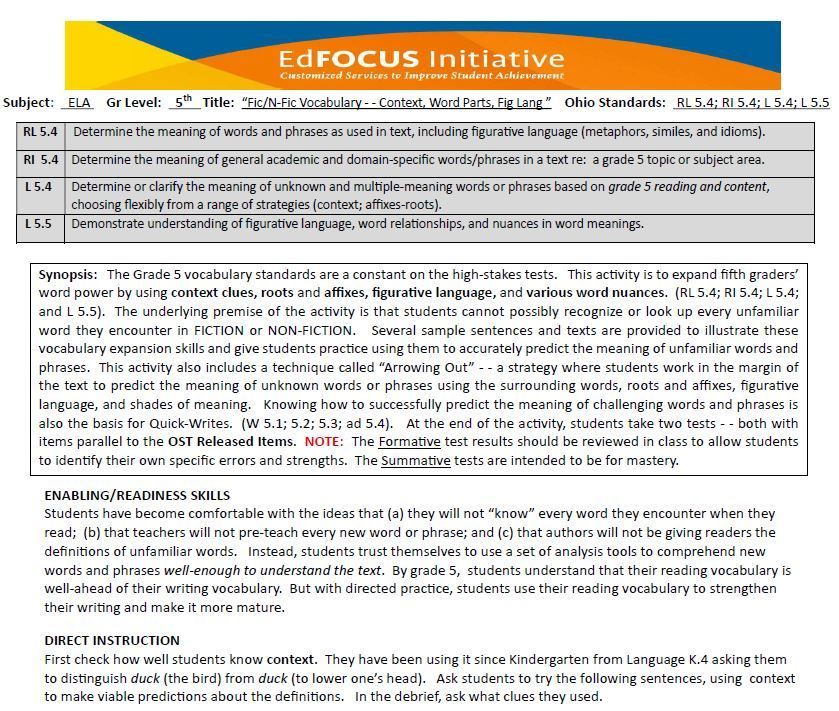Activity Description
Title: Fic/N-Fic Vocabulary - - Context, Word Parts, Figurative Language
This ACTIVITY has a set of teaching-learning strategies proven to increase student mastery of the critical Vocabulary-growth standards in Fiction, Non-Fiction, and Language. Vocabulary is always included on high-stakes tests! Students are expected to use context clues, roots and affixes, figurative language, and various word nuances. The underlying premise of the activity is that students cannot possibly recognize or look up every unfamiliar word they encounter in FICTION or NON-FICTION. Several sample sentences and texts are provided to illustrate these vocabulary expansion skills and give students practice using them to accurately predict the meaning of unfamiliar words and phrases. This activity also includes a technique called “Arrowing Out” - - a strategy where students work in the margin of the text to predict the meaning of unknown words or phrases using the surrounding words, roots an affixes, figurative language, and word nuances. Knowing how to successfully predict the meaning of challenging words and phrases is also the basis for Quick-Writes. (W 5.1; 5.2; 5.3; ad 5.4). [At Grades K-5, each Activity attaches student-sized texts, templates, and test items that teachers can quickly print and use immediately in class.]
Enabling Skills: (a) students will not “know” every word they encounter when they read; (b) teachers will not pre-teach every new word or phrase; and (c) authors will not be giving readers the definitions of unfamiliar words. Students’ reading vocabulary is well-ahead of their speaking and writing vocabulary. As they mature in their Vocabulary-attack skills, they become better - - and more independent - - readers and writers.
Direct Instruction: Suggested teaching strategies are given that model for students what they need to do to begin their journey toward mastery. These strategies include sample sentences and texts to guide authentic practice, requiring students to use context, roots and affixes, figurative language, and the various -nyms (synonyms, antonyms, homonyms, shades of meaning) to predict the meaning of unfamiliar words and phrases. The “Arrowing Out” texts provide students the opportunity to predict word meaning in the context of the entire passage. Several FICTION and NON-FICTION texts are provided for students to use their Vocabulary-attack skills and then verify or correct the predicted meaning.
Quick-Writes: Standards-based writing prompts are provided that require students to document that they have internalized the core ideas of the standard(s) and can show independent mastery. In this Activity, students use unfamiliar words or phrases to write sentences that show they understand the word or phrase.
High-Stakes Look-Alike Assessments: At Grades 3-8, the Activities include two tests - - one for practice - - followed by classroom analysis of errors made - - and the second test to determine mastery. The test items are constructed to look exactly like those items students will encounter on their High-Stakes Tests. In this Activity, BOTH Fiction and NON-Fiction texts are included.
CUSTOMER: Thanks for considering this Activity as part of your approach to your state’s ELA standards. If you have any comments as to how it worked - - or didn’t! - - we’d welcome them! See the contact information to send us feedback. -- the EdFOCUS Team
This teaching activity comes with one hour of online instruction and guidance from a trained EdFOCUS professional. You will be contacted shortly after purchase with more details.
Product Page

